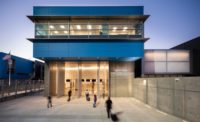Hensel Phelps has a reputation for getting things done—on time and on budget. It’s a theme repeated by clients who compliment the firm’s ability to coordinate design-build projects in condensed time frames, exacting environments and with budgets often set through public policy. And, coupled with a 33% jump in year-over-year regional revenue growth, it’s one of the main reasons Hensel Phelps was named by ENR editors as California’s 2019 Contractor of the Year.
In 2018, Hensel Phelps grew its revenue for California and Hawaii to $1.6 billion, up from $1.2 billion a year earlier, thanks in large part to expansive aviation projects that dot the maps of the Golden State and the Hawaiian Islands.
“They understand all the constraints and all the objectives, all the challenges, and they embrace it.”
– Matt Pearson, Stanford Health Care
Dave Valentine, project development director at the company, pointed to the Greeley, Colo.-based firm’s ongoing work at Norman Y. Mineta San Jose International Airport (SJC), which has consisted of concurrent projects valued at between $10 million and $600 million, as a prime example of how the firm functions under pressure.
When SJC called for bids to build a four-gate interim facility, Hensel Phelps interviewed for the project, was selected in June 2018, received notice to proceed in July and cut the ribbon to open a six-gate interim terminal on June 13. Five gates are currently open; the sixth will open in November.
“It was a $58-million project to be completed in about 11 months for a city government,” says John Aitken, director of aviation at SJC, who worked with Hensel Phelps on the project. “We were able to work with HP to expand the scope to six gates and still stay within the $58 million.”
Hensel Phelps’ delivery has led to big gains for its client: The two extra gates are anticipated to increase rent revenue by $1 million a year per gate while accommodating growing passenger demand. They also will help to propel SJC’s projected 2019 passenger traffic growth to 11% year over year, four times the industry average growth rate of 3%.
Valentine says long-standing relationships with clients like SJC create collaborative and supportive work environments that lead to innovations in the field.
Ongoing Innovations
Aitken agrees. “Our job is to throw out weird stuff, see if it works, and then continue to develop this project in an effective, thought-controlled way,” he says. Aitken notes that roundtable discussions with HP led to efficiencies in other areas, including placing an exit to baggage claim under an existing, elevated structure instead of building it from scratch. “There’s a benefit to having an established relationship on Day 1, you can go right into a project being creative,” he says.
Matt Pearson, vice president of planning, design and construction at Stanford Health Care, is working with Hensel Phelps to complete the fifth floor of Lucile Packard Children’s Hospital at Stanford University—while the rest of the hospital remains open and fully operational. That requires meticulous coordination by Hensel Phelps to maintain a quiet, steady and sterile construction zone where hospital staff can halt construction operations at any time if they feel patient care is affected.
“They really do get it. They understand all the constraints and all the objectives, all the challenges, and they embrace it. They go at it,” Pearson says. The completed fifth floor will house two new wings for patient beds—one for stem-cell patients and one for oncology patients—in addition to a pharmacy.
“They do what they say they’re going to do, and they’re very, very conscientious. They never lose sight of what they’re there to do, and they do it exceptionally well,” he says.
Damian Buessing, vice president and district manager for the Southern California region of Hensel Phelps, says the firm is seeing demand across all sectors, especially in aviation and higher education, including the University of California and California State University systems.
And in Southern California, a key market trend is renovation.
“Owners are looking to maximize existing real estate portfolios and how they can repurpose what they have in place more than we have seen in the past,” Buessing says. “In lieu of tear down and rebuild, it’s more of a repurpose, and do so while remaining in operation.”
Valentine also sees continued growth in government and mission-critical and data center construction across the state. And while the company embraces the fast pace of tight building timelines, Hensel Phelps’ growth strategy is to move at a more deliberate pace.
“We are not a revenue-driven company; we are a value-driven company,” says Valentine, who notes that while Hensel Phelps takes on projects that make big headlines, the firm doesn’t shy away from smaller, less shiny work that clients need to have done.
“I am being super selective about the opportunities we are considering moving forward,” Valentine says. “We really want to make sure we can continue to take care of our great clients and provide value for them and to them.”
Part of that growth strategy is to expand Hensel Phelps’ California workforce by 20%. Valentine says its Northern California employee pool has grown by 49 employees year to date and expects to exceed the firm’s new-hire goal for 2019, with Southern California following a similar trajectory.
“Our goals are long term, and we’re looking to continued steady growth in the market,” Buessing says. “And right now, we are on track.”








Post a comment to this article
Report Abusive Comment